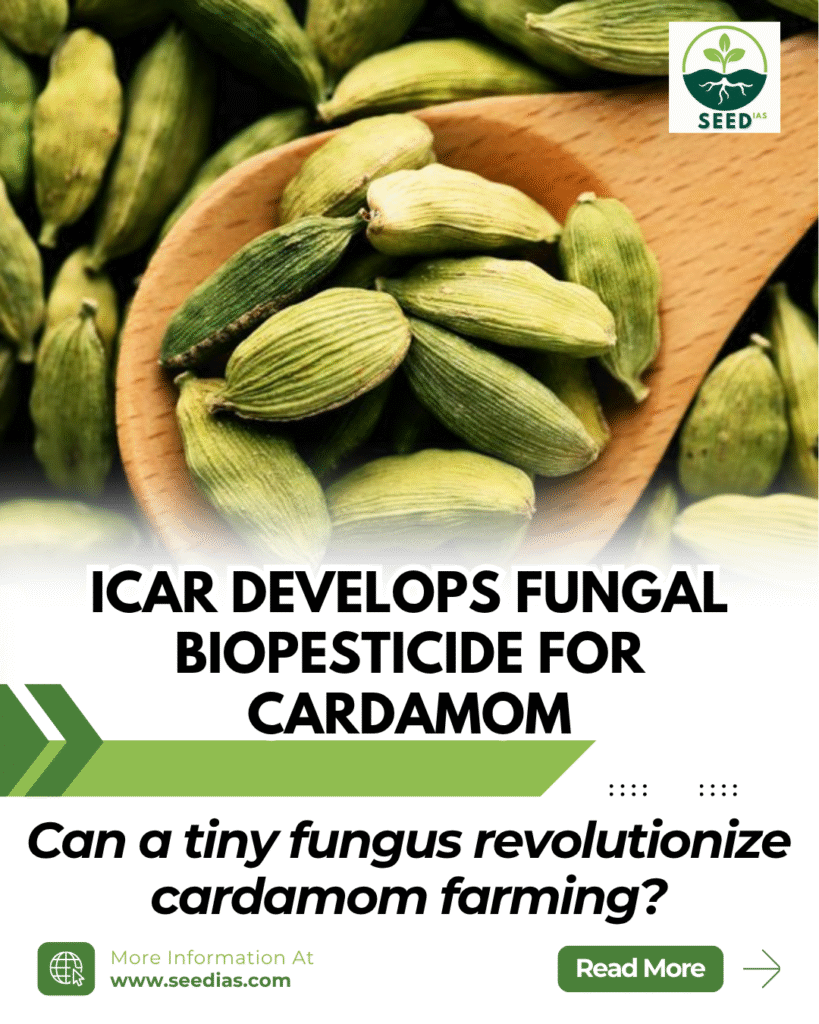Why in NEWS
The ICAR-Indian Institute of Spices Research (ICAR-IISR), Kozhikode, has developed a granular biopesticide using the fungus Lecanicillium psalliotae to control cardamom thrips, a major pest threatening India’s cardamom production.
Key Terms and Concepts
| Term | Explanation |
|---|---|
| Lecanicillium psalliotae | A naturally occurring fungus that infects and kills insects like cardamom thrips by penetrating their body and feeding on internal tissues. |
| Cardamom Thrips (Sciothrips cardamomi) | A major pest affecting cardamom plantations; it damages young leaves and flower buds, reducing yield. |
| Biopesticide | A pest control product derived from natural materials such as fungi, bacteria, or plant extracts that is eco-friendly and target-specific. |
| Granular Formulation | A solid pesticide format where the active ingredient is embedded in or coated on granules for easier field application and controlled release. |
| Farmyard Manure (FYM) | Decomposed mixture of cattle dung, urine, and straw used as an organic fertilizer that enhances soil health and nutrient content. |
| Integrated Pest Management (IPM) | A farming approach combining biological, cultural, mechanical, and chemical tools to manage pests in an environmentally and economically sustainable way. |
| Export Residue Standards | International safety limits for chemical residues in agricultural exports; biopesticides help meet these strict norms. |
| Beauveria bassiana & Metarhizium anisopliae | Other widely used entomopathogenic fungi for pest control; they act similarly to Lecanicillium psalliotae by infecting and killing insect pests. |
What is Lecanicillium psalliotae-Based Biopesticide?
| Aspect | Details |
|---|---|
| Nature | A granular biopesticide developed from Lecanicillium psalliotae, a fungus naturally infecting cardamom thrips (Sciothrips cardamomi). |
| Mode of Action | Penetrates pest’s outer body, feeds internally, effective on larvae, pupae, and adult stages. Acts by contact. |
| Application | Mixed with farmyard manure (FYM) and applied 3–4 times around the base of the plant. |
| Benefits | Reduces chemical pesticide use, cost-effective, boosts root development, enhances nutrient uptake. |
| Environmental Impact | Non-toxic, eco-friendly, supports Integrated Pest Management (IPM), and safe for export by complying with residue norms. |
| Comparison | Belongs to the same group as Beauveria bassiana and Metarhizium anisopliae—fungi used globally for biological pest control. |
What are Granular Biopesticides?
Biopesticides with active ingredients from microbes or plants embedded in granules for easy and slow release during application.
Key Facts Related to Cardamom
| Feature | Details |
|---|---|
| Scientific Name | Elettaria cardamomum |
| Nickname | “Queen of Spices” |
| Family | Zingiberaceae (Ginger family) |
| Origin | Native to the Western Ghats’ evergreen rainforests |
| Climate Requirement | 1500–4000 mm rainfall, 10°C–35°C temperature, altitude 600–1500 m |
| Soil Requirement | Acidic loamy soils rich in humus with pH 5.0–6.5 |
| Top Producing Countries | Guatemala (1st), India (2nd), Sri Lanka (3rd) |
| Top Producing States in India | Kerala (58% of Indian production), Karnataka, Tamil Nadu |
| Newly Identified Species | Elettaria facifera (Periyar Tiger Reserve), Elettaria tulipifera (Agasthyamalai Hills and Munnar) |
In a Nutshell (Memory Code: FUNGI-CARD)
F – Fungus-based eco biopesticide
U – Used with FYM
N – Non-toxic to humans and nature
G – Granular application
I – IPM compliant
C – Cardamom thrips target
A – Altitude-based growth (600–1500 m)
R – Rainfall (1500–4000 mm)
D – Discovered new Elettaria species
UPSC Prelims Practice Questions
- Which of the following fungi is used in biopesticides to control cardamom thrips?
a) Trichoderma viride
b) Metarhizium anisopliae
c) Lecanicillium psalliotae
d) Rhizobium leguminosarum - Consider the following statements about cardamom cultivation:
- It prefers alkaline soils with a pH of 7.5–8.5.
- It grows best in altitudes ranging from 600–1500 meters.
Which of the above is/are correct?
a) 1 only
b) 2 only
c) Both 1 and 2
d) Neither 1 nor 2
- The term “granular biopesticide” refers to:
a) A chemical formulation with liquid encapsulation.
b) A plant hormone in powder form.
c) A microbial pesticide embedded in granules for controlled release.
d) A fungicide used for hydroponic systems.
Mains Practice Questions
- How do biopesticides contribute to sustainable agriculture? Evaluate their role in India’s spice cultivation with recent examples. (GS 3)
- Discuss the importance of Integrated Pest Management (IPM) and how India can balance productivity and environmental safety in plantation crops. (GS 3)
Prelims Answer Key and Explanation
| Qn | Answer | Explanation |
|---|---|---|
| 1 | c) Lecanicillium psalliotae | Recently developed by ICAR-IISR specifically for cardamom thrips control. |
| 2 | b) 2 only | Cardamom prefers acidic soils (not alkaline) and grows between 600–1500 meters altitude. |
| 3 | c) | Granular biopesticides are solid formulations of bio-agents for slow and targeted pest control. |
















